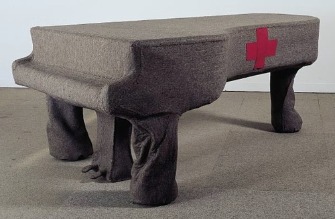Piano keys are made of wood that’s weighted with metal, and faced with plastic in place of what used to be ivory. They are levers. How exactly a musician touches these sticks may or may not alter the physical sound the piano makes.
The cultivation of legato — the binding together of successive tones produced with flexible wrist — is an important aspect of classical piano training.
Some of us wonder about the science of legato, of what we teach and do. How is it that flexible-wrist-resilient-fingers playing is causing the black box to yield the precious sound elixir? Maybe it’s our perception of sound that’s altered with these carefully cultivated gestures? (In helping students, I believe it’s important to listen and not watch as they work on this technique.)
I’ve prescribed playing on a kitchen sponge to discover the combined physical sensation of resistance and giving way that is legato. A padded chair seat will do.
 Perhaps if piano keys were just made with upholstered key tops? Of course our fingers are themselves “padded.” An awareness of the sensation of their give, a physical sensitivity of the finger tips, may be part of legato, part of “singing” tone, of cantabile playing. In Roland Barthes opinion, the pad of the fingers is “the only erotic part of a pianist’s body.”
Perhaps if piano keys were just made with upholstered key tops? Of course our fingers are themselves “padded.” An awareness of the sensation of their give, a physical sensitivity of the finger tips, may be part of legato, part of “singing” tone, of cantabile playing. In Roland Barthes opinion, the pad of the fingers is “the only erotic part of a pianist’s body.”
To cultivate toneful legato, a colleague tells students to imagine their wrists are moving through a big pot of honey. But unavoidably that mental picture reminds me of Karen Finley’s performance piece in which her skin really was honey-doused.
Anything for legato.

The level of obsession among pianists with making their instrument sound less like itself, and more like the voice has always disturbed me. It seems that all musicians have ambitions or aspirations that extend beyond the capabilities of their individual instrument, but when it evolves into a technical instrumentalism I think we take a step away from the music.
In masterclasses I often hear pianists talk of “tone” which seemed a lazy and inarticulate way of describing why the sound of the piano takes on certain characteristics in a given context. Can you really modify the “tone” of a single note based on the way you depress the key? With very few exceptions, the playing a single note on a piano does not allow much room for “tone”.
These sorts of discussions come so close to alchemy that while not without value, they are often unproductive.
All that being said, I am a rotten pianist.
Bruce Brubaker comments:
In playing a single key on the piano — you may be right. I was trying to concentrate on connecting two or more notes and not to dwell on the quality of a single tone. This discussion has been going on a while. Otto Ortmann was doing his experiments during the first part of the 20th century…
Shouldn’t the hall acoustics be taken into consideration when trying to produce legato? I would think that the length of sound decay would be of crucial importance, and that there is no uniform “legato technique” that would work in every concert hall. (But I am not a musician, so this is only a speculation.)
My piano teacher used to have “spoon” shaped fingers, that I swore allowed him to produce a sound that was much more delicate, elegant, and smooth sound than my stick skinny fingers. I agree that the touch of the finger can have a significant impact on the resulting sound that is produced from the piano. Still working on it…
-Theresa